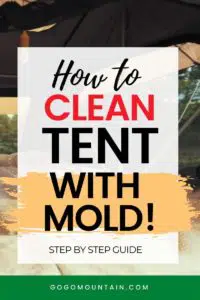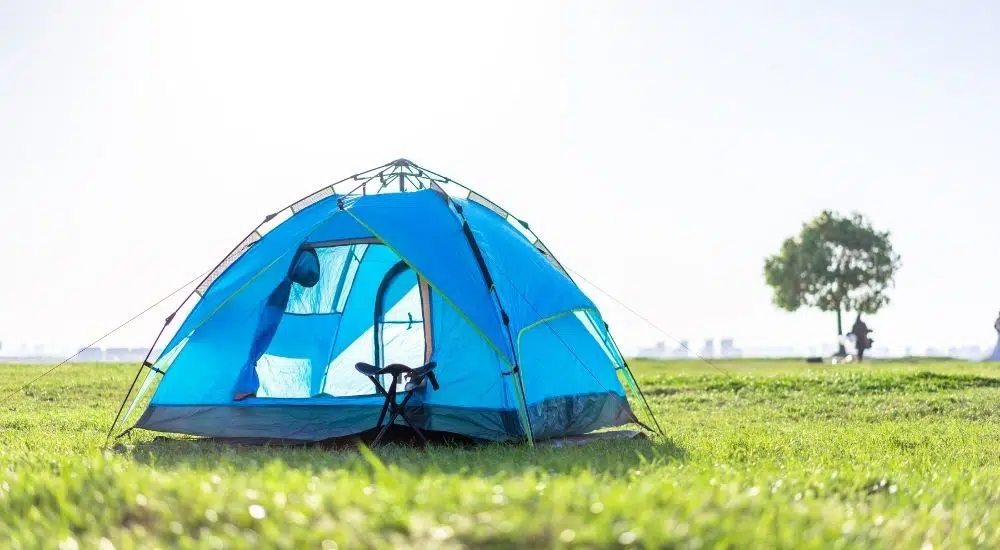How to Clean a Tent With Mold – 6 Step Guide
Mold can grow on tents and inside camping tent walls because it is stored in high humidity areas, are improperly stored, the tent has had water leaks or condensation issues. You’ll want to know how to clean a tent with mold as soon as possible.
You can use a mold remover spray on your tent that is safe for fabrics and indoor use since it’s indoors while you’re outdoors. This mold remover is a buffered bleach so it’s safe for colored fabrics and outdoor fabrics while it removes mold and mildew stains on contact.
We all know that poor ventilation can cause mold to grow. Excess mold can lead to respiratory problems. However, good cleaning and proper storage can keep mold away from your favorite tents.
Read on for more ways and reasons that mold grows on camping tents.

How to Clean a Tent With Mold – Step by Step Guide
Cleaning a tent is an easy operation that doesn’t need to be too complicated. Soap, water, and a good mold cleaner for tents are all the tools needed to eliminate mold from tents.
1. Remove excess mold with soap, warm water, and scrub the tent with a sponge
Soap and warm water are the first cleaners to get rid of excess mold from tents. This mixture helps clear mold, stains, and dirt from the tent easily.
While some people use dishwasher soap, regular soap can be just as effective. At the same time, some of these soaps are made with pleasant fragrances which make the tent smell good as mold often comes with a damp, wet dog odor.
It may not be enough to use warm water and soap on a tent to eliminate mold. You need to scrub in the water-soap mixture with a sponge. If there’s mold on the inside of the tent you should scrub the interior walls as well as the outer walls.
3. Use a magic eraser for difficult stains
Sometimes you’ll be able to get superficial stains out by scrubbing with a magic eraser that is damped with water. This works well for stains that does not come off easily with soap and water.
4. Use oxygen bleach or specific mold remover to deep clean the moldy areas in the tent
A natural solution to clean mold on the tent is using oxygen bleach. They come in liquid form or powder form that need to be diluted in warm water.
Wear cleaning gloves. Then, wet a dry cloth in the solution. Wipe over the moldy areas.
Keep the area wet for 5-10 minutes before drying with a cloth. This gives it a chance soak in and work on the mold.
If you want to use a mold remover for the tent, you can use one that is safe to use on colored fabrics.
5. Rinse the tent with clean water
After thoroughly scrubbing the tent it’s important to rinse it well with clean water. This will eliminate any leftovers and possible drying marks from the soap. You can use a clean sponge or a wet towel to completely rinse the tent with clean water. Alternatively, you can spray clean water on the tent a few times to rinse it before letting it dry.
6. Set up the tent in direct sunlight or in front of a workshop fan for drying
You’ll want to make sure to dry the tent thoroughly. When you place the tent in direct sunlight for drying for at least a couple of hours after washing it, it can be a good way to make sure it is dry.
A freshly cleaned tent indoors will need the help of floor fans or a workshop fan to help it dry completely.
If you’re camping in cold weather, you should leave the tent to dry for a few extra hours when you get the chance.
Try a hairdryer on low heat at hard-to-reach spots like the corners where condensation collects. That’s because water doesn’t evaporate as quickly in cold weather.
If you’re at home, set it up with a blower fan for quick drying before storage.
How to Clean a Tent with Moldy Smell using the MiraZyme Tent Cleaner
Even after removing mold from tents, there might still be an unpleasant heavy smell inside. This smell can only be removed with a dedicated cleaner which eliminates odors. MiraZyme Tent Cleaner is ideal for eliminating odors, especially from a tent with mold.
Spray tent with the cleaner mixed with water
You can mix 0.5 oz of MiraZyme with 12 oz of warm clean water and spray the tent with an even coat. Especially on the areas with mold. Alternatively, you can use a sponge to apply the mixture. Some people prefer to apply it with soap, but this can take a bit longer than spraying.
Scrub the tent with MiraZyme and a sponge
Scrubbing is still required to get rid of mold and odors when using MiraZyme. The advantage of this odor-eliminator is that it relies on natural ingredients, ideal for cleaning the tent without any damage to the fabrics.
Rinse and let the tent dry
A tent without odors or mold is a tent that’s always clean. This is why you need to rinse it properly after every cleaning process. Rinsing the tent is easy as you can use clean cold water. The tent then needs to be air-dried completely.
Reasons for Mold Growth on Tents
Mold is present on most tents that aren’t cleaned and stored correctly. It can start off with a small amount that’s barely visible and eventually cover large areas of the tent. Here are the main reasons for mold formation on tents.
Improper storage
Storing the tent in high humidity areas can trigger mold formation. Keeping your tent in the basement where there’s high humidity isn’t recommended. Tents should not be stored outside either as they take a very long time to dry in their storage bags if rained upon.
Not cleaning the tent frequently
Tents should be cleaned after each use. High humidity and condensation inside the tent can be caused by breathing, especially in multi-person tents.
This is why allowing the tent to properly ventilate as well as cleaning it on the outside is recommended after each use. Put the tent out when you’re at home and use a blower fan to dry the tent thoroughly before long term storage.
Condensation
Packing your tent away in the early hours of the morning can mean there’s condensation or morning dew left on your tent. Sometimes, the water is trapped because our camping equipment is stored tightly. This could cause uninvited mold to grow on your tent.
Water leaks
If a tent isn’t properly waterproofed, it’s bound to suffer from mold. Water that gets inside the tent rarely gets to evaporate completely, essentially leading to mold in time.
You can apply a water shield to increase the water resistance of your tent’s fabric. It’s easy to apply. Spray the surface from 8 inches away. Then, let it dry. You can repeat the step if you feel like you’ve missed a spot.
Things to Avoid When Cleaning a Tent With Mold
There are right and wrong ways of cleaning mold from a tent. You might be tempted to clean it as mold inside the house or as mold on clothes but you want to avoid the following mistakes.
Don’t machine wash the tent
A tent with mold should not be washed in the washing machine. This will destroy its materials and it will not do much in removing the mold since there’s no scrubbing.
Don’t use bleach
Regular bleach can remove mold from certain surfaces, but not from tents made from canvas or polyester. It will destroy its fibers rather than eliminate mold. It’s also toxic if not rinsed thoroughly with clean water.
Avoid abrasive cleaners
Abrasive cleaners have the same negative effect on tent materials as bleach. They can destroy its fiber and eventually rip the tent.
How to Prevent Future Mold Formation On The Tent
You can keep mold away from the tent by taking care of it after each use. Minimum care is needed but you should only pack up the tent when properly cleaned and dried.
-
Store the tent in a dry place
The tent needs to be stored in clean dry places at home. The garage and the basement are sometimes places where mold forms due to high humidity. It’s best to store the tent away from these places.
-
Clean and dry the tent after every use
Each tent needs to be cleaned from dirt and food traces after every use. You should also only pack the tent when completely dried to keep mold away. Leaving its doors and windows open, placing a powerful fan will quickly dry it inside.
Setting the tent up in a dry place for outside drying under a good sunny day is also ideal before taking it down.
Conclusion
You can use a mold remover spray on your tent, or a mixture of oxygen bleach and water, to eliminate mold.
However, odors can still be smelled in a tent even after cleaning all mold. An odor eliminator like Mirazyme is a good solution to thoroughly clean the tent’s polyester or canvas fabrics.
Properly air-drying the tent after cleaning also helps get rid of leftover odors. Tents need to be dried after each use, on the outside and inside, because breathing creates heat, humidity, and condensation that settles on the walls favoring mold to grow.
Finally, storing a tent properly will prevent future mold problems from happening. This usually means keeping the tent inside the house and not in damp areas. If you want to keep it in the basement, monitor the moisture levels in your basement year-round with a dehumidifier with autodrain. Keeping the tent in areas with fluctuating humidity is how water particles from high humidity will air bond to the tent. It’s surprisingly quick and would favor mold formation.
How to Clean Pop Up Camper Vinyl
Kelty Salida 4 Person Tent Review – 4 BEST Pros vs. Cons for Camping and Backpacking









